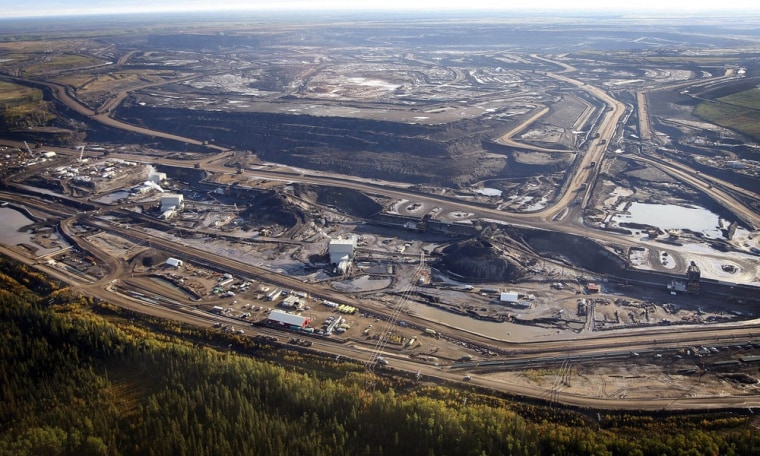Time is almost out to avoid a climate catastrophe that would leave today's children and future generations with a world starkly different from the one that nurtured civilization for the past 10,000 years, according to one of the world's most eminent climate scientists.
Left unchecked, for example, rising global temperatures could soon cross thresholds that melt enough ice in Greenland and Antarctica to drown all of the world's existing coastal cities in rising seas.
Crossing such tipping points would also doom millions of creatures to extinction as well as cause deserts to expand, food shortages to rise and infectious diseases to spread.
"Yet we are going in exactly the wrong direction in the sense that we are encouraging searching for every fossil fuel that can be found," James Hansen, a retired NASA climate scientist now affiliated with Columbia University in New York, told NBC News.
Carbon fee
To reverse course, Hansen proposes to hit the biggest carbon polluters where they feel it most — their bank accounts.
Hansen says a carbon fee could be charged to fossil fuel companies. Those companies that reduce their fossil fuel use will make more money, spurring innovation in carbon-free energy. In case the counter argument is that the fossil fuel companies would just pass the charge along to their customers, Hansen says that funds (raised from the fee) could be distributed back to the public to offset the higher costs.
Such an economic lever, Hansen explained, would ratchet down greenhouse gas emissions and keep most of the remaining fossil fuel reserves in the ground. The scheme would limit warming to about 1 degree Celsius (1.8 degrees Fahrenheit). "We would be in pretty good shape," he said.
MORE: Sudden climate woes scarier than gradual impacts: study
Hansen and colleagues from throughout the climate science and economic communities make their arguments in a paper published online Tuesday in the journal PLoS One. The paper, which took about three years to write and publish, is largely a synthesis of existing climate science.
Climate science and policy experts who are not affiliated with the study noted the paper repackages existing arguments made by Hansen, who retired from NASA earlier this year to more actively advocate for political and legal efforts to limit global warming.
Hansen, for example, is the leading voice against construction of the Keystone XL pipeline, which would transport crude oil extracted from Canadian tar sands to refineries on the U.S. Gulf Coast.
The paper is also "part of a larger scale migration away from the scientifically conservative position that one has to be extraordinarily sure there is a climate change signal before undertaking difficult and extreme countermeasures," Kerry Emanuel, an atmospheric scientist at the Massachusetts Institute of Technology, told NBC News in an email.
The shift, he continued, is toward a view that "even a low-probability existential risk to future generations warrants strenuous efforts to reduce that risk."
Carbon budget battles
To limit warming to 1 degree Celsius, Hansen and colleagues argue, no more than a cumulative total of 500 gigatons of carbon can be burned and an additional 100 gigatons of carbon must be stored in the forests and soils.
"It is pretty clear we are going to pass 500 gigatons of carbon at the rate we are burning it up, which is about 9 gigatons a year now," Hansen said. "But it makes a huge difference whether you moderately pass that or whether you just keep charging ahead the way we are now, which guarantees we are going to go way past that."
This carbon budget is roughly half the amount the United Nations climate change panel said the world could emit and stand a decent shot at keeping global temperature rise below an internationally agreed target of 2 degrees Celsius (3.6 degrees Fahrenheit).
Hansen said he and his colleagues have "tried to make clear that this 2 degree C target that everyone seems to accept now is actually a recipe for disaster." If the world warms 2 degrees, it would spur so-called "slow" feedbacks in the climate system such as methane release from melting permafrost and ice-free oceans absorbing more heat.
These slow feedbacks could lead to actual warming of 4 to 6 degrees Celsius (7.2 to 10.8 degrees Fahrenheit) — a scale that could disintegrate the Greenland and Antarctic ice sheets to the point "that the dynamics and momentum of the process take over," the team writes in PLoS One.
"At that point, reducing greenhouse gases may be unable to prevent major ice sheet mass loss, sea level rise of many meters, and worldwide loss of coastal cities — a consequence that is irreversible for practical purposes."
To avoid such disastrous consequences, Hansen and his colleagues advocate keeping temperatures to roughly within the range of the past 10,000 years, a geologic epoch known as the Holocene.
"If we just pretend that we don't understand this and that it's okay if we go ahead and keep going after every fossil fuel that we can find," Hansen warned, "we are guaranteeing that there are disasters lying ahead for young people and future generations."
John Roach is a contributing writer for NBC News. To learn more about him, visit his website.
